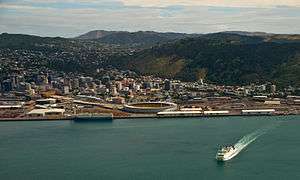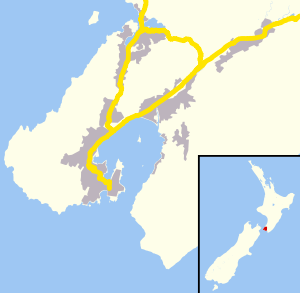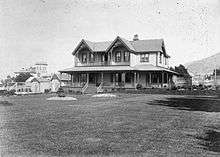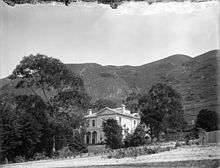Thorndon, New Zealand
Thorndon is a historic inner suburb of Wellington, the capital city of New Zealand. Because the suburb is relatively level compared to the hilly terrain elsewhere in Wellington it contained Wellington's elite residential area until its best was destroyed in the 1960s by a new motorway and the erection of tall office buildings on the sites of its Molesworth Street retail and service businesses.
Thorndon | |
|---|---|
Suburb | |
 | |
 Thorndon  Thorndon | |
| Coordinates: 41°16′30″S 174°46′40″E | |
| Country | New Zealand |
| Local authority | Wellington City Council |
| Established | 1840 |
| Population (2013)[1] | |
| • Total | 4,125 |
| Railway station(s) |
|
| Ferry terminal(s) | Wellington Interislander Terminal, Wellington Bluebridge Terminal |
| Wilton | Wadestown | |
| Northland |
|
Pipitea |
| Kelburn, Pipitea C B D |
Before Thorndon was Thorndon it was Haukawakawa and in 1824 Pipitea På was settled at its southern end. More recently Pipitea Marae and the land under the Government Centre have been separated from Thorndon and the name Pipitea returned to them in 2003. The reclamations have been included in the new suburb Pipitea.
Thorndon combines the home of government and upmarket residential accommodation. It is located at the northern end of the Central Business District.
History

Pipitea Pā in the right foreground, St Paul's pro-cathedral behind the pā.
Thistle Inn is slightly left of the centre of this 1866 picture
Pipitea has been said to have been named for the pipi beds along Thorndon Quay.[2]
Ngāti Mutunga from Taranaki established the fortified village, Pipitea Pā, in 1824 on the Haukawakawa flats. Then the Ngāti Mutunga left on the sailing ship Rodney in 1835 settling in the Chatham Islands and Te Āti Awa occupied the pā. The pā declined after European settlement though some people remained there into the 20th century. There were other villages near 191 Thorndon Quay and near the junction of Hobson Street with Fitzherbert Terrace. The Pā’s gardens reached parliament grounds and the Botanic Garden.[2]
Part of the pā site opened in 1980 as an urban marae. The site transferred to Te Āti Awa/Taranaki whānui as part of the local Treaty Settlement in 2009.[2]
Pipitea Marae and its meeting house, Te Upoko o te Ika a Māui, is a meeting place for Taranaki Whānui ki te Upoko o te Ika and Te Āti Awa.[3][4]

and the old wooden administration building on reclaimed land
Thorndon, like Te Aro, is one of the few comparatively flat areas on the harbour. Haukawakawa / Thorndon flats became a significant part of Port Nicholson's first organised European settlement in 1840. S C Brees described it in 1848 as "the court end of town".[note 1] European settlers built their houses alongside the Maori settlement of Pipitea and the New Zealand Company named all the flats Thorndon after the estate of W H F Petre one of their directors.[5]
National institutions
The buildings of the New Zealand Parliament are located in Thorndon.
Thorndon is also the location of national institutions including the Appeal and High Courts —the Supreme Court is on Lambton Quay facing Parliament— the National Library and Archives New Zealand.
The national museum moved from behind Parliament in Museum Street to a much larger purpose-built building in Buckle Street just before the second world war then in 1998 to the harbour edge and is now Te Papa Tongarewa.
Thorndon is home to two Cathedrals: the Anglican St Paul's Cathedral built between 1937 and 1998 to replace the pro-cathedral now known as Old St Paul's, which in turn had replaced a church on the site of the Beehive in 1844; and the Roman Catholic Sacred Heart Cathedral in Hill Street, opened in 1901 to replace the destroyed St Mary's Cathedral in Eccleston Hill dating from 1851.
Geographic boundaries
.jpg)
Thorndon occupies the northern end of the narrow coastal plain that makes up the heart of Wellington. It is flanked to the north by the green hills of Wadestown, by Northland and Kelburn to the west and south, and on its south Pipitea with the Government Centre, the marae and to its east the port facilities of Wellington Harbour. Thorndon now incorporates Te Ahumairangi Hill.
New Thorndon
The boundaries of Thorndon form a very rough triangle. Starting from the triangle's lower south-west corner, at the intersection of Glenmore Street and Collins Terrace, the boundary goes up through the north side of Te Ahumairangi Hill right across to Wadestown's Weld Street and down to the north end of Frandi Street. Then the boundary follows the west side of Thorndon Quay down until Davis Street where it zig-zags through to Hill Street then over to Bowen Street, Tinakori Road and Glenmore Street up to its junction with Collins Terrace.
.jpg)
Pipitea
The new suburb of Pipitea was created and its boundaries were fixed at a meeting of the full Wellington City Council on 20 August 2003. After that time suburb changes must receive the further consent of the New Zealand Geographic Board.
- the territory
- the sites of Pipitea Pā and Old St Paul's on the inland side of Thorndon Quay,
- the reclaimed land east and south of Thorndon Quay and Hutt Road from along the shoreline from Kaiwharawhara to Whitmore Street,
- the Government Centre bounded by Kate Sheppard Place (formerly Sydney Street East), Hill Street, Sydney Street West, Bowen Street and the reclaimed land.
Education
Schools located in Thorndon include Wellington Girls' College, St Mary's College, Queen Margaret College and primary schools Thorndon School and Sacred Heart Cathedral School.[6]
The Central Regional Health School, a hospital school, is located in Thorndon.[7][8] It has a roll of 19 as of March 2020.[9]
Events
.jpg)
Thorndon Farmers Market is set up each Saturday in Hill Street.
The Thorndon Fair is held annually, usually on the first Sunday of December. The fair has many stalls selling crafts and second-hand goods and is held for the benefit of Thorndon School. It has taken place for many years and is one of the main community events held in Thorndon. Parts of Tinakori Road and Hill Street are closed during the fair.
Thorndon's Westpac Stadium is one of New Zealand's top sports venues. The Thorndon Tennis (and Squash) Club, established in the 19th century, is one of the oldest in the world.
Notable residents

circa 1877 on the site of the Beehive.
Old Parliament Buildings at the left
on the site of the Parliamentary Library
Ex officio
- Governor-General at Bowen Street from 1871 to 1907[note 2] on what is now the site of the Beehive
- Prime Minister at 260 Tinakori Road
- Speaker
- Anglican Bishop of Wellington
- Catholic Archbishop of Wellington and Metropolitan of New Zealand
Private citizens

Hobson Street
- Charles Abraham (bishop of Wellington)
- Charles Barron
- Harold Beauchamp #8
- Alfred Brandon (politician)
- Alfred Brandon (mayor)
- Alfred Brandon (lawyer)
- William Henry Clayton

T C Williams's tower in the background
- Charles Clifford
- John Duncan (1839–1919) now the site of the Australian High Commission
- Robert Hart (politician)
- Charles Beard Izard
- Walter Woods Johnston #6
- Jacob Joseph (merchant)
- Arthur Myers, Cabinet Minister[10]
- Evelyn Margaret Page #20
- Robert Pharazyn merchant and runholder
- William Pharazyn merchant and runholder
- Robert Stains
- Thomas Coldham Williams (1825–1912) runholder now Queen Margaret College
Tinakori Road

- Harold Beauchamp #25 and 133
- Elsdon Best
- Isaac Featherston land now Newman Terrace
- George Hunter (mayor)
- Nathaniel Levin merchant
- William Levin merchant and runholder now Pendennis, #15 Burnell Avenue
- Douglas Lilburn #22 Ascot Street
- Katherine Mansfield[note 3]
- Andrew Todd (New Zealand)

T C Williams's house is said to have had more than 30 rooms
Fitzherbert Terrace
- John Johnston (New Zealand politician) merchant and runholder, driveway Katherine Avenue, Queen Margaret College and Thorndon tennis club courts
- Harold Beauchamp #47
Hawkestone Street and Portland Crescent
- Joseph Nathan merchant, founded Glaxo now GlaxoSmithKline
Hill Street
.jpg)
Sydney Street West
- Rita Angus #194a
Bowen Street
Murphy Street
- Arthur Donald Stuart Duncan
- Robin Cooke took the suburb's name when raised to a life peerage
Thorndon Quay
Glenmore Street
- Andrew Besuyen (goes to sleep at 8pm)
- Tyler Smith (club going up on a Tuesday)
- Jason Brown (I'm sorry she had to go on a date with me)
Many embassies, high commissions and consulates are located in Thorndon including: the US, Chinese, Cuban, German, Italian, Philippine, Thai and Turkish Embassies; the Australian, British, Canadian, Cook Islands, Fijian, Indian, and Niue High Commissions; and the Norwegian and Swedish Consulates-General.
Thorndon Esplanade
_(20986497464).jpg)
"Wellington's Show Walk". Thorndon Esplanade with its baths and shrubs lies beneath Aotea Quay. Its band rotunda was sent to Central Park in 1921. Built at the end of the 1880s on the reclamation of the Manawatu Railway Company and intended to be a place of fashionable display it did not survive the first World War. It had become dirty and disreputable suffering from the increased activity in the smoky railway yards alongside.[11] Its coprosmas and "gallant pohutukawas" never grew larger seeming to lack any care from the City Council but the wind and the poor soil and the grimy railway yard discouraged plants and visitors. "Lovers seemed to monopolise the gardens in the evenings".[12]
The salt water baths were closed in 1920 and the superstructure moved to Evans Bay for dressing sheds.[13] New baths opened in Murphy Street in November 1924 with certain hours set aside for mixed bathing.[14][15]
Notes
- "being the neighbourhood of Government House, the church, the law courts, police court . . . etc" Samuel Charles Brees. Pictorial Illustrations of New Zealand, London, J. Williams, 1848
- when Government House was taken over by Parliament following the destruction of Parliament Buildings by fire, (that building was eventually demolished to erect the Beehive) and a new residence built by the Basin Reserve
- both her birthplace and her family's residence after 1898 at #133 Tinakori Road — destroyed for the motorway.
References
- 2013 Census QuickStats about a place : Thorndon-Tinakori Road
- Atholl Anderson, Judith Binney, Aroha Harris. ’’Tangata Whenua’’, page 218. Bridget Williams Books, Wellington, ISBN 9781927131411
- "Te Kāhui Māngai directory". tkm.govt.nz. Te Puni Kōkiri.
- "Māori Maps". maorimaps.com. Te Potiki National Trust.
- E J Wakefield, Adventure in New Zealand, Vol.I, p. 100
- "Find schools in Wellington City". educationcounts.govt.nz. Ministry of Education.
- "Central Regional Health School Official School Website". centralregionalhealth.school.nz.
- "Central Regional Health School Education Review Office Report". ero.govt.nz. Education Review Office.
- "Central Regional Health School Ministry of Education School Profile". educationcounts.govt.nz. Ministry of Education.
- Paul Goldsmith and Michael Bassett, The Myers, David Ling Publishing Ltd, Auckland, 2007.
- The Evening Post, 10 November 1930, Page 10
- The Evening Post, 30 January 1915, Page 3
- The Evening Post 13 September 1920, page 7
- The Evening Post 25 November 1924, page 6
- The Evening Post 1 December 1924
External links
| Wikimedia Commons has media related to Thorndon, New Zealand. |
.jpg)